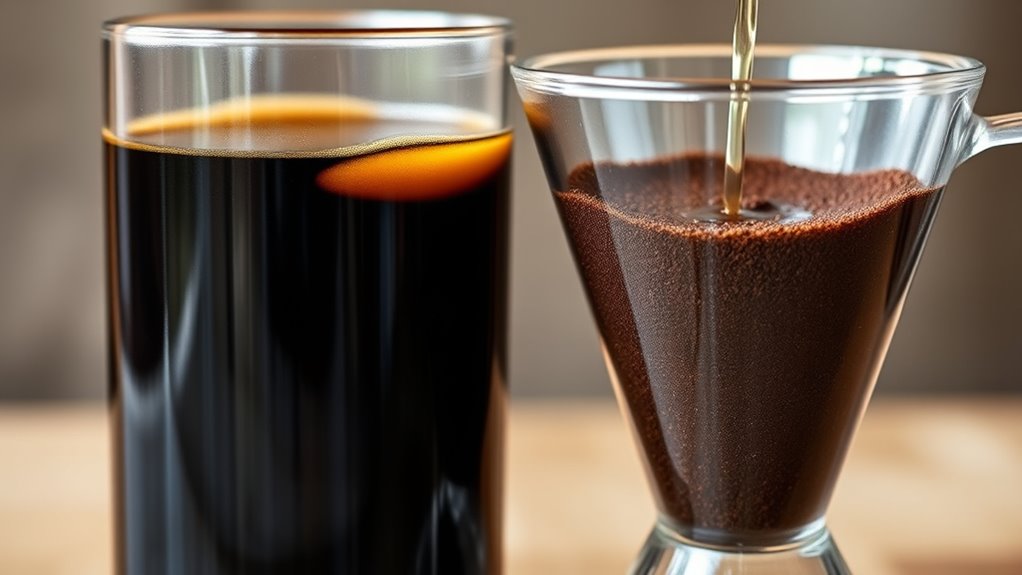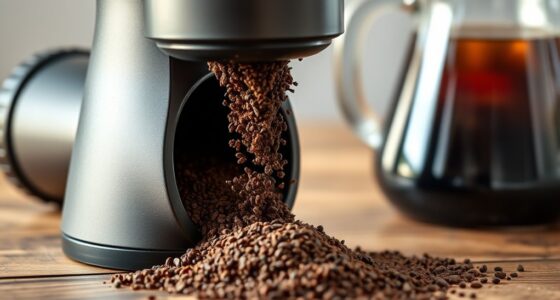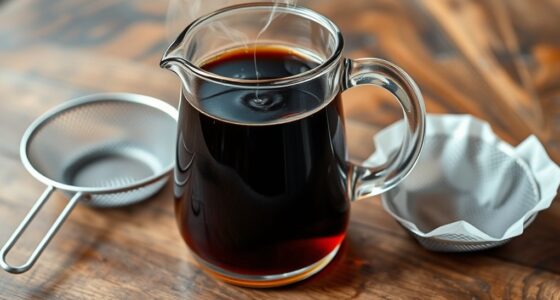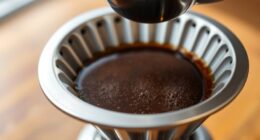Immersion and slow-drip are two popular cold brew methods that shape the flavor differently. With immersion, you fully submerge coffee grounds in water for 12 to 24 hours, resulting in a rich, smooth, and balanced drink. Slow-drip, which takes 3 to 24 hours, involves water gradually dripping through the grounds, producing a clean, bright, and nuanced brew. Continue exploring to discover which method suits your taste preferences best.
Key Takeaways
- Immersion involves fully submerging coffee grounds for 12-24 hours, producing a rich, smooth flavor.
- Slow-drip uses cold water slowly dripping through coffee over 3-24 hours, resulting in a clean, nuanced taste.
- Longer immersion yields fuller-bodied, sweeter brews, while extended slow-drip enhances clarity and complexity.
- Immersion emphasizes richness and minimal fuss; slow-drip offers a delicate, vibrant flavor profile.
- Brewing duration and method choice depend on desired flavor, with patience influencing the final taste experience.
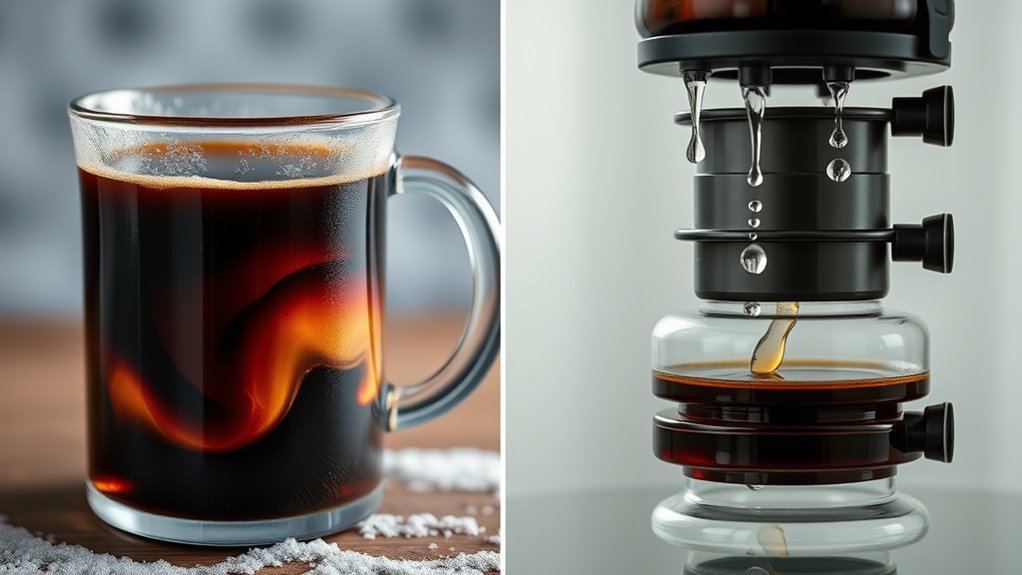
When it comes to making cold brew coffee, two popular methods stand out: immersion and slow-drip brewing. Both approaches bring unique qualities to your cup, mainly influenced by their brewing duration and how they extract flavor from the coffee grounds. Understanding these differences can help you choose the method that best suits your taste and schedule.
Immersion brewing involves submerging coffee grounds fully in cold water for an extended period, typically between 12 to 24 hours. During this long brewing duration, the coffee grounds steep directly in the water, allowing for thorough flavor extraction. The longer the grounds stay in contact with water, the more the coffee’s oils, solids, and aromatic compounds are released. This process results in a rich, smooth, and often sweeter flavor profile, as the slow extraction minimizes bitterness and acidity. The emphasis on flavor extraction during immersion is gentle but thorough, giving you a well-rounded cold brew with a balanced taste.
Immersion brewing steeps coffee grounds fully for 12-24 hours, producing a rich, smooth, and balanced cold brew.
In contrast, slow-drip brewing employs a controlled process where cold water drips slowly through a bed of coffee grounds, often over several hours. This method typically takes between 3 to 24 hours, but the key difference lies in the drip rate and the controlled flow of water. Because water interacts with the grounds gradually, the flavor extraction happens in a more measured and precise way. The slow drip ensures that delicate flavors are extracted without overdoing it, producing a clean, crisp, and nuanced cup. The extended drip time allows for a steady extraction of aromatic compounds, resulting in a more refined and complex flavor profile.
While both methods demand patience, the brewing duration directly influences the final taste. Immersion brewing’s longer time tends to produce a fuller-bodied, sweeter, and sometimes more robust cold brew. Slow-drip, with its meticulous control over the flow, yields a lighter, brighter, and more vibrant flavor. Your choice ultimately hinges on how much time you want to invest and the flavor characteristics you prefer. If you’re after a rich, smooth brew with minimal fuss, immersion is ideal. If you enjoy a cleaner, more delicate cold brew with intricate notes, slow-drip might be your go-to. Both techniques highlight the importance of brewing duration in shaping flavor extraction, proving that patience truly pays off when crafting your perfect cold brew.
Additionally, brewing time plays a vital role in determining the final coffee profile, making it essential to select the method that aligns with your taste preferences and schedule.
Frequently Asked Questions
Which Method Preserves More of the Coffee’s Natural Oils?
You’ll find that immersion cold brew preserves more of the coffee’s natural oils than slow-drip. This method involves steeping coffee grounds fully submerged, allowing for rich coffee extraction and better oil retention. Because the grounds stay in contact with water longer, the oils stay intact, resulting in a fuller, more robust flavor. Slow-drip, on the other hand, filters out some oils, leading to a cleaner but slightly less oily brew.
How Does Brewing Time Affect Flavor Complexity?
Brewing time substantially impacts flavor complexity, with longer durations enhancing flavor development. For example, cold brew steeped for 24 hours develops richer, more nuanced tastes compared to shorter steeping times. As brewing duration increases, you’ll notice a deeper, more layered profile, allowing the coffee’s natural oils and aromas to fully emerge. So, if you want a complex flavor, extend your brewing time, but avoid over-extraction to prevent bitterness.
Can These Methods Be Easily Adapted for Home Use?
Yes, both immersion and slow-drip methods are easily adaptable for home brewing. You can customize your equipment, like filters or brewing containers, to suit your preferences. Immersion requires just a jar or pitcher and a filter, while slow-drip needs a simple setup with a dripper and a collection container. With some experimentation, you can perfect your cold brew at home, tailoring flavor and strength to your taste.
What Equipment Is Necessary for Each Brewing Style?
Think of your brewing setup like assembling a band; each piece plays a crucial role. For immersion, you’ll need a large jar or pitcher, a filter, and a spoon—simple equipment for a straightforward brewing process. For slow-drip, you’ll require a specialized cold brew tower or dripper, a container for collecting, and a steady drip source. The equipment comparison highlights how each method’s brewing process influences your choice, shaping your perfect cold brew.
Are There Health Benefits Associated With Either Method?
You might notice health benefits with either cold brew method, as both enhance caffeine extraction and preserve antioxidant levels better than hot brewing. Cold brew’s smooth, less acidic profile can reduce stomach discomfort, while high antioxidant content supports overall health. Though differences are subtle, choosing a method that maximizes caffeine and antioxidants can boost your energy and wellness, making both techniques beneficial depending on your preferences.
Conclusion
Ultimately, choosing between immersion and slow-drip cold brew boils down to your taste and patience. Some say the longer the brew, the richer the flavor, but that’s not always true—sometimes, less time reveals more nuance. Trust your palate and experiment. Remember, it’s not just about method; it’s about discovering what makes your perfect cup. So, embrace the process and enjoy the journey of crafting your ideal cold brew experience.
